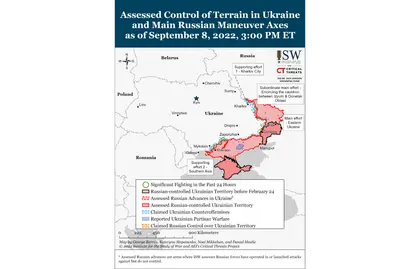Key Takeaways
- Ukrainian successes on the Kharkiv City-Izyum line are creating fissures within the Russian information space and eroding confidence in Russian command to a degree not seen since a failed Russian river crossing in mid-May.
- Ukrainian forces in the Kharkiv Oblast counteroffensives advanced to within 20 kilometers of Russia’s key logistical node in Kupyansk on September 8.
- Ukrainian forces will likely capture Kupyansk in the next 72 hours, severely degrading but not completely severing Russian ground lines of communication (GLOCs) to Izyum.
- Ukrainian forces are continuing to target Russian GLOCs, command-and-control points, and ammunition depots in Kherson Oblast.
- Russian occupation authorities continue to intensify crackdowns and filtration measures to curb Ukrainian partisans and pro-Ukrainian saboteurs.
- Russian forces conducted limited ground attacks across the Eastern Axis.
Ukrainian successes on the Kharkiv City-Izyum line are creating fissures within the Russian information space and eroding confidence in Russian command to a degree not seen since a failed Russian river crossing in mid-May. Ukrainian military officials announced that Ukrainian forces advanced 50km deep into Russian defensive positions north of Izyum on September 8, but the Russian Ministry of Defense (MoD) notably did not issue any statement regarding Ukrainian advances in Kharkiv Oblast.[1] Ukrainian successes and the Russian MoD’s silence prompted many Russian milbloggers to criticize and debate Russian failures to retain control over the city of Balakliya, approximately 44km northwest of Izyum. Some milbloggers claimed that Russian forces fully or partially withdrew from Balakliya in good order, while others complained that Ukrainian forces beat Russian forces out of the settlement.[2] Others noted that Rosgvardia units operating in the area did not coordinate their defenses or have sufficient artillery capabilities to prevent Ukrainian counterattacks in the region.[3] Milbloggers warned about an impending Ukrainian counteroffensive northwest of Izyum for days prior to Ukrainian advances, and some milbloggers noted that Russian command failed to prepare for “obvious and predictable” Ukrainian counteroffensives.[4] Others noted that Ukrainian forces have “completely outplayed” the Russian military command in Balakliya, while others encouraged readers to wait to discuss Russian losses and withhold criticism until Russian forces stabilize the frontlines.[5]
JOIN US ON TELEGRAM
Follow our coverage of the war on the @Kyivpost_official.

EU Transfers €1.5 Bln Raised From Russian Assets for Ukraine
The current tone and scale of Russian milblogger criticism echo the response to Russia’s loss of a large amount of armor in a failed Russian river crossing in Bilohorivka, Luhansk Oblast, in May.[6] ISW assessed at the time that the catastrophic Russian losses suffered due to incompetence shook the confidence of pro-Russian milbloggers, sparking criticism of the Russian war effort. Russian milbloggers and social media users accessed satellite imagery that showed devastating losses of Russian military equipment, which caused many to comment on the incompetence of the Russian military and analyze the scene on a tactical level. The Russian MoD did not comment on the situation, fueling burgeoning doubts about Russia’s prospects in Ukraine.
The Russian MoD repeated its Bilohorivka information mistake by failing to acknowledge the situation around Kharkiv Oblast and establish a desired narrative, leaving milbloggers to fill this gap with criticism of Russian forces. The Russian MoD only claimed to have destroyed a Ukrainian ammunition depot in Balakliya.[7] Some milbloggers complained that the Russian MoD did not seize the information space in a timely manner to prevent the spread of Ukrainian social media on Russian Telegram channels, leading to distrust among Russian audiences.[8] Milbloggers largely supported the Russian MoD’s narratives that the Ukrainian counteroffensive in Kherson Oblast had completely failed just days prior to Ukrainian breakthroughs in Kharkiv Oblast.[9] Such a shift in milblogger perceptions of Russian progress in Ukraine can be partially attributed to the flaws in the Russian war-time information strategy, namely that:
- The Russian MoD struggles to address unexpected Ukrainian operations because its information strategy relies on portraying the Russian invasion of Ukraine as an easy and faultless operation. This promotes a lack of situational awareness within the Kremlin and the Russian media space.
- The Russian MoD needs a significant amount of time to develop and spread false narratives in the Russian information space. The Kremlin and Russian MoD successfully did so prior to the long-awaited Ukrainian counteroffensive in the south, and milbloggers largely followed the Kremlin’s line. The Russian MoD failed to have a narrative ready for Ukrainian operations in Kharkiv Oblast.
- Milbloggers will share and promote footage and imagery of fighting unfavorable to Russian forces that will dominate coverage in the Russian information space if the Russian MoD does not provide its own media.
Authors: Kateryna Stepanenko, Grace Mappes, George Barros, Layne Philipson, and Mason Clark
See the full report here.
You can also highlight the text and press Ctrl + Enter






